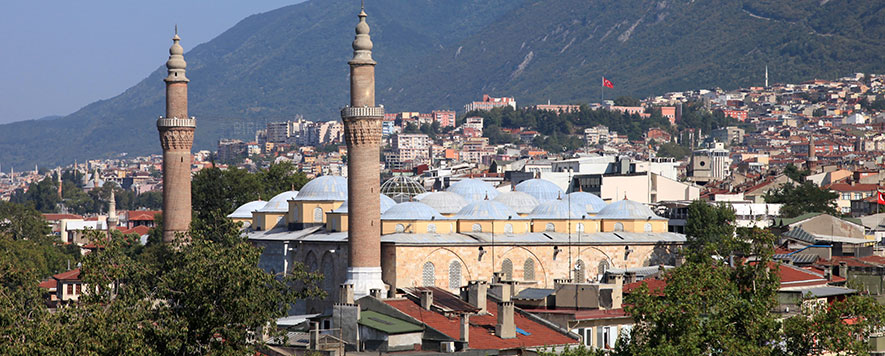Bursa Green Pages from History

BURSA
Bursa gained its historical importance during the reign of the Ottomans and Orhan Ghazi made Bursa the capital of the Ottoman Principality. After the conquest of Edirne in 1361 it became the capital of the European lands of the Ottomans while Bursa continued to serve as the capital of the Anatolian lands. When Istanbul was conquered in 1453, it became the only capital. Bursa then became a Sanjak, and in the 19th century it became the seat of the province. The main historical buildings are Fortress of Bursa, Yıldırım Complex(Mosque, Madrasah, Hamam, Darüşşifa, Bedesten), Yeşil Complex(Green mosque, Green Tomb, Yeşil İmaret, Yeşil Hamam), Emir Sultan, Tophane Park, Ulu Camii(The Grand Mosque), Caravanserais(Koza Han, Emirhan, Fidan, İpek, Geyve and Pirinç), Monumental Grave of Karagoz-Hacivat, Sultan Murat Hüdavendigar Complex.
In Bursa, buildings from the three main religions can be seen. The Etz Chaim(Tree of Life) Synagogue was the first synagogue built during the Ottoman Period. The Geruş(Exiled) Synagogue and the Mayor( Resettled Jews from Mallorca) Synagogue are other important Jewish religious buildings.
Cumalıkızık Village , there are seven kızık villages, which have unique culture and historic architecture, set amongthe fantastic natural landscapeof the lower northern slopes of Uludağ(Mount Olympus) at a 15-20 minute drive away from the centre of Bursa. The term kızık refers to the narrow valleys in which the villages are confined. The most attractive of them is Cumalıkızık Village. It is an Ottoman foundation village which is 700 years old. In the village you can find some of the best examples of Ottoman civic architecture. With its narrow, irregular streets where the two and three-storey houses are huddled together, the village is like an open air museum. The streets - in some places it is too narrow for two people to pass each other- are cobbled with flagstones, and there is a shallow gully along the centre of the street to carry water away. The ground floors of the houses are rubble stone masonry embedded with timber beams. While modern comforts do already have a foothold in the village, local customs and traditions still survive.
Uludağ(Mount Olympus) is 36 kilometres South of Bursa in the North Anatolian mountain range and with its 2543 metre height it is the tallest mountain in the region. Uludağ is one of the most important winter sports center in Turkey with skiing taking place for four months of the year. The center provides facilities for Alpine and Nordic disciplines as well as ski touring and heli-skiing, and because of its proximity to the main Turkish cities, its good transport infrastructure and superb accomodation, it is popular holiday choice.
Iznik(Nicaea), the county is situated on the eastern shore of Iznik Lake. Iznik was an important tolerant centre during the Roman, Byzantine, Seljuk and Ottoman periods in regard to its administrative as well as religious position. The first Ecumenical Council of the Christian Church was held in 325 AD at the palace of Senate, and the Seventh Ecumenical Council of Nicaea, was held in 787 AD in the Ayasofya Church in İznik. Both councils were extremely influential and many important decisions were taken at these councils. The city walls of İznik are still standing, which unfortunately has not been the case for many other historic cities. During its long history İznik suffered from several powerful earthquakes and on each occasion it was repaired and extensively renovated. The county still proudly displays masterpieces from the Roman to the Ottoman periods. İznik’s attractive Roman masterpieces are: the City Walls which are approximately 5 kilometres long; the Lefke and Istanbul Gates on the city walls; the Theatre; the Stone Bridge and Beştaş Mounument(Obelisk). Byzantine masterpieces are: the famous Ayasofya Church(now called the Ayasofya Museum); the Underground Grave(Hypogeum) with its intricate floral and figurative frescos; Böcek Ayazması(Holy spring), and the Aqueducts. Ottoman masterpieces are: the Yeşil Mosque, famous for its green tiles; and many other historic tombs, hammams and madrasahs. Iznik Lake, Sansarak Canyon and the monumental trees provide some of the natural beauty of the region.
The ceramic art of Iznik flourished under the Seljuk influence and it gained a new perspective with the Ottomans. The first major example to the tile decoration of the Ottomans is the Green Mosque(Yeşil Cami) of Iznik dating from the 16th and 17th centuries. The famous Ottoman traveller, Evliya Çelebi, visited İznik in the 17th century and reportedthat there were 300 tile kilns operating in İznik. Most of the architectural masterpieces in Istanbul used İznik tiles. The distinguishing feature of İznik tiles are the specific blue, turquoise, green and red colours, as well as the stylised tulip, hyacinth, pomegranate and carnation figures.
